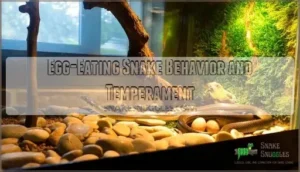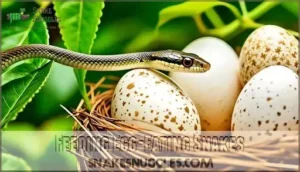This site is supported by our readers. We may earn a commission, at no cost to you, if you purchase through links.
 Most pet snakes gulp down rodents without a second thought, but egg-eating snakes have carved out an entirely different evolutionary niche—one that makes them both fascinating to observe and uniquely challenging to keep. These specialized African serpents have evolved hinged jaws and reduced teeth to swallow bird eggs whole, then use modified vertebrae to crack the shell internally before regurgitating the fragments.
Most pet snakes gulp down rodents without a second thought, but egg-eating snakes have carved out an entirely different evolutionary niche—one that makes them both fascinating to observe and uniquely challenging to keep. These specialized African serpents have evolved hinged jaws and reduced teeth to swallow bird eggs whole, then use modified vertebrae to crack the shell internally before regurgitating the fragments.
While their docile temperament and lack of venom make them appealing for keepers seeking something different, their dietary requirements demand commitment and creativity that standard snake care doesn’t prepare you for.
Understanding whether an egg-eating snake fits your husbandry skills and lifestyle requires examining their specialized needs—from sourcing appropriately sized eggs year-round to creating enclosures that accommodate their climbing behavior and support their unusual feeding process.
Table Of Contents
- Key Takeaways
- What Are Egg-Eating Snakes?
- Popular Egg-Eating Snake Species
- Egg-Eating Snake Behavior and Temperament
- Setting Up The Ideal Enclosure
- Substrate, Hides, and Terrarium Décor
- Lighting and UVB Requirements
- Temperature and Humidity Control
- Feeding Egg-Eating Snakes
- Health, Lifespan, and Common Issues
- Suitability and Ethical Considerations
- Frequently Asked Questions (FAQs)
- Do egg-eating snakes make good pets?
- What pet snakes only eat eggs?
- How to care for an egg-eating snake?
- Are egg-eating snakes venomous?
- Are egg-eating snakes legal to own everywhere?
- How do you introduce live eggs safely?
- Can egg-eating snakes cohabitate with other species?
- What type of eggs are easiest to source?
- How do I source fresh eggs regularly?
- What happens if my snake refuses eggs?
- Conclusion
Key Takeaways
- Egg-eating snakes require specialized care centered on sourcing fresh, appropriately sized bird eggs year-round—a non-negotiable commitment that separates them from standard snake husbandry and demands strategic planning beyond typical reptile keeping.
- These African serpents possess remarkable evolutionary adaptations, including hinged jaws that accommodate eggs five times wider than their heads, modified vertebrae that crack shells internally, and a complete absence of venom, making them physically harmless but dietarily demanding.
- Proper enclosure setup requires vertical space for climbing (minimum 36"L x 18"W x 36"H), stable temperature gradients (95-100°F basking spot), 40-60% humidity, and low-intensity UVB lighting designed for shade-dwelling species to support calcium absorption and immune function.
- Despite their docile temperament, egg-eating snakes aren’t suitable for beginners due to steep learning curves in sourcing eggs, managing feeding refusals, navigating conservation concerns around wild-caught specimens, and maintaining the specialized environment their unique biology demands.
What Are Egg-Eating Snakes?
If you’ve ever wondered about egg-eating snakes, you’re not alone. These intriguing reptiles have some unique quirks that set them apart.
Before we look at the best enclosures for them, let’s get to know what makes them special.
Dasypeltis Species Overview
If you’ve ever wondered about a snake with a taste for nothing but eggs, meet the fascinating Dasypeltis—a group of reptiles that have carved out a truly unique niche in the wild.
Across Africa, Dasypeltis scabra, Dasypeltis gansi, and Dasypeltis fasciata show striking adaptations, with subtle geographic variations in their physical characteristics, evolutionary history, and conservation status marking each species’ identity.
Unique Feeding Adaptations
That egg-eating snake diet? It’s a masterclass in evolutionary engineering. You’ll spot jaw flexibility that lets these snakes take eggs five times wider than their heads. Their vertebral spines crack shells internally, while esophageal projections keep the feast moving smoothly. Remarkably, chemical sensing points them straight to eggs, slashing the metabolic cost of feeding habits compared to traditional colubrids. As it happens, studies show that Dasypeltis exhibit specific egg preferences.
- Unmatched jaw flexibility accommodates enormous egg size
- Vertebral spines efficiently break the eggshell from within
- Chemical sensing makes certain precise selection and identification of suitable eggs
Natural Distribution
While those feeding quirks set them apart from the crowd, understanding where egg-eating snakes call home helps you see just how well their unique talents fit into the wild tapestry of Africa, Madagascar, and beyond.
These reptiles inhabit forests, savannas, and rocky outcrops spanning African habitats, the Arabian Peninsula, and the Madagascar range—each habitat reflecting striking adaptation to diverse, endemic regions.
Popular Egg-Eating Snake Species
Regarding keeping egg-eating snakes, a few species tend to stand out for their adaptability and charm. Each brings its own quirks to the table, which can influence your care routine.
Let’s take a closer look at the ones most keepers choose.
Dasypeltis Scabra
If you’ve ever wondered what it looks like when adaptation gets creative, just meet the Dasypeltis scabra—a snake so fine-tuned for eating eggs, it’s practically a master safecracker in scales. Scabra morphology features flexible jaws, intricate scalation details, and notable color variations. In the wild, their diet consists almost exclusively of eggs. Captive breeding remains rare for these unique eggeating snakes.
Dasypeltis scabra is a master safecracker in scales—a snake so fine-tuned for eating eggs, it cracks shells internally with specialized vertebral spines
- Distinctive ridge-like dorsal scales aid camouflaged movement.
- Color variations range from sandy beige to deep olive.
- Specialized vertebral spines help crack shells internally.
- Their wild diet is limited to bird eggs; nothing else interests them.
- Captive breeding success is limited, making wild-caught specimens much more common.
Indian Egg-Eater (Elachistodon Westermanni)
Curiosity has a way of leading you to the remarkable, and few reptiles capture that spirit quite like the Indian egg-eater, Elachistodon westermanni. This snake’s skeletal adaptations allow it to swallow and crack eggs with surgical precision—a true marvel of dietary specialization.
Rare in captivity, its conservation status remains precarious, underscoring the importance of ethical snake care, habitat specifics, and responsible enclosure setup.
Key Differences Between Species
When you compare egg-eating snake species, the distinctions leap out: size variations often reflect their natural habitat specifics, while scale patterns can reveal evolutionary stories. Some snakes favor quail eggs over others—a nod to unique egg preferences. Temperament differences, too, are real; one species may be docile, another skittish.
These Egg-Eating Snake Characteristics shape care, housing, and every aspect of Egg-Eating Snake Habitat. These snakes, belonging to the Dasypeltis genus, eat bird eggs.
Egg-Eating Snake Behavior and Temperament
Getting to know how egg-eating snakes behave will help you create the right home for yours. Their habits and temperament shape what they need in their space.
Here’s what you’ll want to pay attention to as you consider enclosure options.
Activity Patterns
Ever notice how some snakes come alive just as the lights go down? Egg-eating snakes skew nocturnal, slipping from their hides to forage at dusk. Their hunting behavior hinges on seasonal changes—warm nights spark activity, while chill or dry spells slow them down.
Environmental impact shapes sleep patterns and thermoregulation, blending animal instinct with the subtleties of the reptile environment.
Handling Tips
Getting hands-on with an egg-eating snake is a bit like learning the secret handshake of a gentle club—approach with patience, and you’ll quickly earn their trust.
Use proper snake interaction techniques: support the body, avoid rapid movements, and recognize cues of stress.
Limit interaction frequency, stick to good hygiene practices, and always prioritize the snake’s comfort for safe, positive interactions.
Typical Temperament
Think of an egg-eating snake as the introvert at the party—calm, reserved, and happiest when simply left to do its own thing. Most of the time, you’ll notice a docile nature, punctuated by subtle Defensive Behaviors if stressed.
Interaction frequency should stay low, as stress indicators vary. Remember—individual variation in snake behavior makes learning proper snake interaction techniques critical for success.
Setting Up The Ideal Enclosure
Getting the enclosure right is where your egg-eating snake’s wellbeing truly begins. There are a few key things you’ll want to get in place from the start. Here’s what to look for as you set up their new home.
Minimum and Optimal Enclosure Size
Picture your egg-eating snake stretching out comfortably—the right enclosure size is more than a number, it’s where your snake can feel at home and thrive. For optimum long-term health, aim for at least a 36”L x 18”W x 36”H plastic or glass tank.
Consider:
- Vertical space for climbing
- Ample enrichment needs
- Sufficient terrarium size
- Future growth considerations
- Ideal cage size for activity
Essential Terrarium Features
Once you’ve nailed down the right enclosure size, it’s time to focus on the touches that turn a simple tank into a space where your egg-eating snake can really show off its natural behaviors. Ventilation needs top the list—healthy airflow keeps your snake thriving.
Prioritize secure lids, easy cleaning access, appropriate substrate, temperature gradient, humidity control, and some aesthetic appeal in your terrarium setup.
Cohabitation Considerations
Before you start planning for more than one snake, it’s worth knowing that egg-eating snakes are happiest living solo in their enclosures. Housing multiples increases stress, resource competition, and the risk of dominance hierarchy or injury. Disease transmission also becomes more likely.
Individual habitats—each with adequate terrarium size—contribute to stress reduction and healthier snake behavior, both in habitat and during interaction.
Substrate, Hides, and Terrarium Décor
Choosing the right setup makes a world of difference for your egg-eating snake’s comfort and health. With the right base, good hiding spots, and things to explore, your snake will feel right at home.
Here’s what you’ll want to think about for each part of the enclosure.
Best Substrate Options
Choosing the right substrate sets the stage for your egg-eating snake’s comfort, health, and natural behaviors. Weigh your options thoughtfully:
- Coconut coir—top pick for humidity retention and substrate safety.
- Aspen shavings—ideal for digging behavior, but monitor for mold.
- Newspaper—cost-effective, but limits enrichment.
- Orchid bark—excellent for mold prevention and supporting natural activity.
Select what fits your balance of needs.
Providing Hides and Climbing Structures
Now that you’ve picked the right substrate, adding plenty of hides and branches gives your egg-eater a chance to feel secure and stretch those climbing muscles. Think about strategic hide placement to foster that “invisible” feeling snakes crave, and opt for sturdy limbs—structural integrity counts for climbing safety.
Embrace naturalistic design when decorating the terrarium for real enrichment variety in your enclosure.
Enrichment and Decoration
With the right mix of enrichment and thoughtful décor, you can turn your snake’s enclosure into a living landscape that keeps both body and mind active. Try weaving climbing branches among visual barriers, offer puzzle feeders for sensory enrichment, and use substrate material that invites exploration.
Naturalistic setups go beyond aesthetics—thoughtfully decorating the terrarium delivers true value in daily Snake terrarium decoration.
Lighting and UVB Requirements
Lighting can make all the difference for your egg-eater, from health to daily rhythms. The right UVB setup doesn’t just mimic the wild—it aids wellbeing in subtle but important ways.
Here’s what you’ll need to get your lighting just right.
Benefits of UVB Lighting
UVB lighting transforms reptile care by addressing fundamental physiological needs that artificial environments can’t replicate otherwise. When you’re providing proper UVB lighting for your egg-eating snake, you’re fostering essential biological processes that directly influence long-term health and vitality. Here’s how UVB lighting benefits your snake:
- D3 Synthesis and Calcium Absorption – UVB exposure allows your snake to produce vitamin D3 naturally, which activates intestinal calcium absorption and maintains bone mineralization, preventing metabolic disorders.
- Immune Support and Disease Resistance – Adequate UVB strengthens immune function through vitamin D’s immunomodulatory effects, reducing susceptibility to infections and illness.
- Enhanced Activity Levels and Natural Behavior – Reptile lighting requirements include spectrum wavelengths that stimulate appetite, encourage basking behavior, and synchronize hormonal rhythms for peak wellness.
MBD prevention starts with consistent UVB lighting benefits that wild snakes receive naturally under the sun.
Recommended UVB Bulbs
Not every UVB bulb delivers the controlled, low-intensity output that egg-eating snakes need — you’ll want fixtures designed for shade-dwelling species that thrive under filtered light rather than direct sun.
The Arcadia ShadeDweller UVB kit and Zoo Med T8 Reptisun 5.0 provide ideal UVB spectrum and intensity at the proper distance without overwhelming these forest-adapted reptiles.
These fixture types balance bulb lifespan with consistent UVB lighting benefits throughout their 12-month replacement cycle.
Lighting Schedule and Placement
Your lighting schedule should mirror the natural day-night cycle your snake would experience in the wild — getting this rhythm right influences everything from appetite to breeding readiness.
Use a smart timer to guarantee 12 hours of UVB lighting daily, adjusting for seasonal cycling. Position fixtures to create a gentle UVB gradient, and double-check bulb distance to prevent excess temperature near the primary heat source.
Temperature and Humidity Control
Keeping your egg-eating snake healthy starts with meeting its temperature and humidity needs. The right setup makes all the difference in comfort and well-being. Here’s what to know as you consider your enclosure options.
Creating Temperature Gradients
Think of temperature gradients as a weather forecast your snake can control—without a proper range from warm to cool, it just can’t thrive. Set up a clear Basking Spot using reliable Heat Sources and a thermostat.
Your Cool Zone should sit opposite the basking temperature of 95–100°F. Monitoring Temperatures closely guarantees your Dasypeltis meets its thermoregulation needs, maintaining temperature gradients important to its health.
Maintaining Proper Humidity
Ever notice how a rainy day can change the whole mood of a room? Your egg-eating snake feels the same way about humidity. Keep humidity levels at 40–60% using a digital probe hygrometer for accuracy.
Add a humid hide lined with sphagnum moss, mist the enclosure regularly, and watch for signs like Shedding Issues or Respiratory Health concerns—Humidity Monitoring is your safety net.
Using Thermostats and Hygrometers
If you’re chasing perfect humidity and temperature, a good thermostat and hygrometer combo is like having all the right tools to tune up your favorite vintage car—suddenly, everything runs smoother and you catch problems early.
Trust digital probes for accurate readings; calibrate thermostats routinely, and place hygrometers wisely.
Regular probe maintenance matters—analog models rarely compete on precision or reliability.
Feeding Egg-Eating Snakes
Feeding egg-eating snakes takes a bit of know-how, but it’s nothing you can’t master with the right information. The key is understanding which eggs work best, how often to feed, and what to do if your snake turns up its nose.
Let’s break down the essential points to help you keep your snake healthy and satisfied.
Suitable Egg Types and Sizes
Choosing the right eggs for your snake feels a bit like being a chef for a very picky guest—only the freshest, perfectly sized morsels will do.
Bird eggs such as quail eggs or small finch eggs provide excellent nutritional content and manageable eggshell thickness.
Pay close attention to egg freshness, egg size, and egg availability to maintain a healthy egg-eating snake diet.
Feeding Frequency and Methods
Once you’ve picked out the perfect eggs, the real trick is knowing when—and how—to serve them so your snake feels right at home at mealtime. Most egg-eating snakes thrive on a steady feeding schedule, usually one or two eggs per week. Rotate egg size and species, use gentle egg preparation, and try scenting eggs if your snake seems uncertain.
- A missed feeding can leave your snake restless, or worse—stressed.
- Scenting eggs with a small bird feather can spark their appetite.
- Too-large eggs risk regurgitation; always tailor egg size to the individual.
- The ritual of serving the right egg at the right time is part science, part art.
Troubleshooting Feeding Problems
Even with all the right eggs and routines, sometimes your snake just turns up its nose and leaves you scratching your head at mealtime. Refusal Causes—from stress to incorrect temperatures—are common.
Egg rejection may stem from eggs that are too large or lack scent. Try scenting eggs with feathers, check quail egg size, and monitor for regurgitation issues to fine-tune your Egg Eating Snake diet.
Health, Lifespan, and Common Issues
Keeping your egg-eating snake healthy starts with understanding what to watch for and how to provide the right care. Even though these snakes can be hardy, a few common issues sometimes turn up in captivity.
Here’s what to look for as we run through the key aspects of their health and lifespan.
Signs of Illness
Spotting illness in egg-eating snakes demands a sharp eye for subtle changes. Lethargy signs, sudden appetite loss, oral issues like mouth swelling, skin problems, or digestive ailments—such as vomiting or diarrhea—can indicate real trouble.
In-depth knowledge of snake health and reptile husbandry makes all the difference, ensuring reptile health and wellbeing are never left to chance.
Shedding and Hydration
While a perfect shed can feel like a badge of good husbandry, keeping your egg-eating snake hydrated is often the secret ingredient behind that satisfying result. Consistent humidity, a sturdy water bowl, and keen eyes for signs of retained shed or dehydration are essential. Try these tips to master humidity levels and hydration:
- Mist regularly to maintain proper humidity importance
- Offer a shallow water bowl for direct hydration methods
- Use digital hygrometers for temperature and humidity control
- Provide a humid hide to support shedding frequency
- Check skin for retained shed and address promptly
Lifespan in Captivity
It’s not uncommon for egg-eating snakes to keep you company for well over a decade when their needs are met in captivity. Average lifespan varies—ten to fifteen years is typical, compared to much shorter spans in the wild.
Maximizing longevity means vigilant EggEating Snake Care: attentive husbandry, prompt treatment of common ailments, and continual refinement based on the latest reptile care and snake care information.
Suitability and Ethical Considerations
Before bringing an egg-eating snake home, it’s worth weighing the realities and responsibilities of their care.
There are a few key things you’ll want to think about before choosing an enclosure. Here’s what to keep in mind as you narrow down your options.
Pros and Cons as Pets
Owning an egg-eating snake is a bit like inviting a specialist into your home—rewarding for the right keeper, but certainly not everyone’s cup of tea. Care complexity, strict dietary needs, and interaction difficulties demand research and patience. Yet their docile nature and low risk of harm can appeal.
Weigh ethical sourcing, conservation impact, and sustainability before diving into this niche.
Experience Level Needed
Tending to an egg-eating snake isn’t beginner’s luck—it’s a craft that calls for patient hands and a willingness to learn beyond the basics. Egg Eating Snakes demand specialized care, thoughtful snake habitat design, and confidence built on prior snakekeeping.
The learning curve is steep: successful snake restraint, ethical sourcing, and consistent husbandry make these fascinating reptiles beginner unsuitable every step of the way.
Conservation and Legal Regulations
Curious how Trade Regulations and Conservation Status shape your snake keeping? These factors can make or break ethical ownership.
Consider:
- Tightening CITES and USFWS rules on international trade
- Ethics behind wild collection versus captive breeding
- National laws that differ wildly on legal ownership
- Conservation risks from unregulated export
Every choice echoes through conservation, legality, and responsible keeping.
Frequently Asked Questions (FAQs)
Do egg-eating snakes make good pets?
Egg Eating Snakes demand specialized snake husbandry knowledge and unwavering owner commitment to meet their unique dietary needs.
Conservation status and ethical concerns about wild-caught specimens add complexity, making these reptiles challenging for most keepers despite their fascinating feeding adaptations.
What pet snakes only eat eggs?
Like an arrow designed for one target, only Dasypeltis species and the Indian Egg-Eater (Elachistodon westermanni) possess the specialized diet needed for consuming eggs exclusively, making egg availability and ethical sourcing critical considerations.
How to care for an egg-eating snake?
Proper care centers on maintaining stable temperature and humidity levels, sourcing fresh eggs regularly, monitoring health indicators, and providing enclosure maintenance.
You’ll need restraint techniques that minimize stress and enrichment ideas like climbing branches.
Careful attention is required when feeding egg-eating snakes with appropriately sized eggs.
Are egg-eating snakes venomous?
No, egg-eating snakes lack venom glands entirely. Dasypeltis species are harmless reptiles that rely on defensive posturing rather than bites.
Understanding snake behavior reveals they rarely bite, making them safe to pick up despite their intimidating bluffs.
Are egg-eating snakes legal to own everywhere?
Legality varies widely depending on your location. Federal regulations and local species restrictions govern ownership of these specialized reptiles.
Many regions require permits for wild-caught animals, and CITES regulates international trade to guarantee ethical collection and sustainability.
How do you introduce live eggs safely?
Feeding tongs promote secure use while preventing injury to you or your snake.
Start with a gradual introduction using appropriately sized quail eggs based on gape width. Select fresh eggs at room temperature, avoiding refrigerated ones.
Size selection matters—choose eggs matching your egg-eating snake’s head dimensions for successful consumption.
Can egg-eating snakes cohabitate with other species?
Mixing species in a reptile habitat is like introducing strangers at a dinner party where only one guest can actually eat—tension inevitably rises.
Cohabitation isn’t recommended for egg-eating snakes due to interspecies aggression, resource competition, disease transmission risks, and stress.
Your snake enclosure should house only one individual to guarantee stress reduction and ideal health.
What type of eggs are easiest to source?
Quail egg availability makes button quail eggs your best bet—they’re sold at local farms, Asian markets, and online reptile nutrition suppliers. Finch egg sourcing takes more effort, but breeding societies help.
Egg storage methods matter: refrigerate extras, but warm to room temperature before feeding egg-eating snakes.
How do I source fresh eggs regularly?
Finding fresh eggs isn’t always a walk in the park—local farms and avian breeders are your best bet.
Contact button quail or finch breeders directly for consistent egg quality and appropriate egg size for your eggeating snake diet, ensuring proper storage methods and feeding frequency align with reptile nutrition needs.
What happens if my snake refuses eggs?
Refusal may signal underlying illness, environmental stressors, or incorrect egg variety. Check egg freshness and try button quail eggs.
If feeding frequency seems off, adjust timing. Assisted feeding helps reluctant Egg-Eating Snake feeding only temporarily—consult a veterinarian.
Conclusion
Deciding whether egg-eating snakes as pets suit your setup demands honest evaluation of your dedication and resources. These specialized serpents transform routine reptile care into year-round strategic planning—sourcing fresh quail or finch eggs becomes non-negotiable, not optional.
Yet for keepers who embrace the challenge, watching these gentle serpents execute their egg-swallowing ballet rewards patience with pure evolutionary poetry in motion.
- https://a-z-animals.com/animals/rhombic-egg-eater-snake/
- https://imperialreptiles.com/blogs/care-sheets/egg-eating-snake-care-sheet
- https://www.morphmarket.com/us/c/reptiles/colubrids/more-colubrids/782183
- https://www.backwaterreptiles.com/snakes/egg-eating-snake-for-sale.html
- https://undergroundreptiles.com/product/west-african-egg-eating-snake/

















